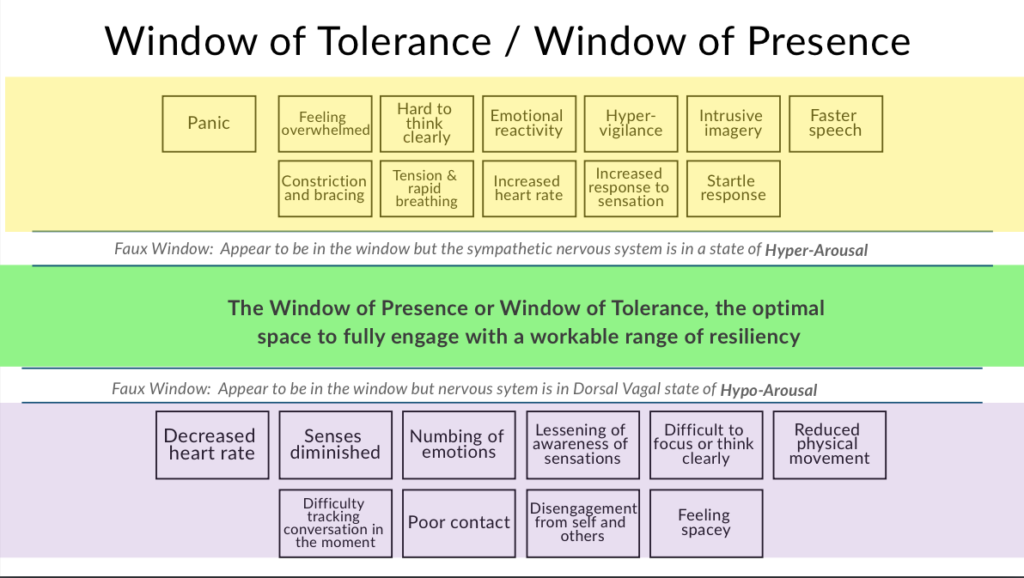A Simple Tool to Manage Stress: the Window of Tolerance
The Window of Tolerance is a tool that helps us understand how our bodies react to stress and trauma. Developed by Dr. Dan Siegel, it shows the “optimal zone of arousal,” where we feel calm and in control, even during stressful situations. This zone is where we can manage our emotions without feeling overwhelmed.
But when stress or trauma hits hard, our body reacts by shifting out of this window, either by going into hyperarousal or hypoarousal.

Hyperarousal: When You’re Too Stressed
When you are above the Window of Tolerance, your body enters the hyperarousal state. In this state, you may experience feelings of panic, anxiety, fear, or irritability. You may feel overly alert, like you’re constantly on edge or defensive. This is also where unhealthy coping mechanisms like overeating, addictions, or anger issues can start.
Symptoms of Hyperarousal:
- Panic or fear
- Anxiety or irritability
- Difficulty relaxing or sleeping
- Constant alertness (hypervigilance)
Hypoarousal: When You Shut Down
If you drop below the Window of Tolerance, you enter the hypoarousal state. This is where feelings of sadness, depression, or numbness can appear. In this zone, you might feel disconnected from your body, zoned out, or unable to remember things clearly. You may even find it hard to get started on tasks or feel constantly tired.
Symptoms of Hypoarousal:
- Depression or sadness
- Feeling emotionally numb
- Difficulty starting or finishing tasks
- Fatigue and low energy

Why Understanding the Window of Tolerance Matters
Knowing your Window of Tolerance is important because it helps you recognize when your body is under stress and how you react. Understanding your reactions can lead to better self-awareness and help you stay calm under pressure. Instead of feeling shame or frustration over how you react to stress, this tool encourages self-compassion and helps you manage your emotions more effectively.
How to Expand Your Window of Tolerance
We all move in and out of our Window of Tolerance daily. The good news is that you can take steps to stay within the optimal zone for longer periods, which helps you handle stress better.
Here are some proven ways to do this:
- Mindfulness and Breathing Techniques: Simple practices like deep breathing, meditation, or mindfulness exercises can help calm your nervous system and bring you back into the optimal zone. One technique is called “square breathing,” where you breathe in for four seconds, hold for four, exhale for four, and then hold again for four.
- Get Professional Support: Working with a trauma-informed therapist can help you understand your stress reactions better. A good therapist will help you find personalized solutions to expand your Window of Tolerance.
- Body Awareness: Therapists trained in somatic experiencing help you understand how your body stores trauma. Noticing your physical sensations can help you connect emotions to bodily responses, leading to healing.
- Prioritize Self-Care: Self-care isn’t just about treating yourself—it’s about maintaining a balance between rest and activity, joy and relaxation. Doing activities that make you happy and recharge your energy can help keep you in your optimal zone.
Final Thoughts: Managing Stress With Self-Awareness
Remember, moving in and out of your Window of Tolerance is normal throughout the day. Instead of aiming to eliminate all stress, focus on recognizing your emotional states, noticing when you’re stressed, and using tools like breathing and mindfulness to stay balanced.
By becoming aware of how you react to stress, and learning how to stay within your optimal zone, you can manage challenges with more resilience and peace.
Resident Therapist
Nicole Thompson













